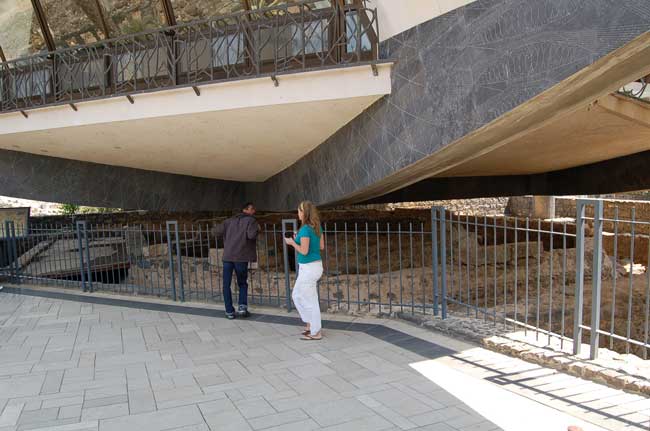
The symbols of the menorah, incense shovel, and shofar on a capital are proof of the building's use as a synagogue.
ISRAEL PHOTOS IV -- Pilgrimage |
Matthew 11 (WEB)
23 You, Capernaum, who are exalted to heaven, you will go down to Hades. For if the mighty works had been done in Sodom which were done in you,
it would have remained until today.
One pilgrim who arrived at Capernaum when it was a jumbled pile of building stones sticking up out of the ground exclaimed, "Capernaum was cast down to hell." Jesus had predicted such a fate for the town he knew in the first century. The largest Roman ruins discovered along the north shore of the lake were Capernaum (Tel Hum), Bethsaida (Et Tell), and Magdala (Medjel).
From Egypt to Palestine, by S.C. Bartlett, NY, 1879:
“It was but a few steps from the shore, fringed with oleanders, to Tell Hum, a heap of ruins almost hidden by rank weeds. Through a space extending half a mile in length, by a fourth of a mile in breadth, we walked and stumbled over foundations and fallen walls of ancient houses. We also spent time in studying out the ruins of the “White Synagogue,”... It was a building of some seventy-five feet by fifty-six. And though it has been mostly demolished, there still remain Corinthian capitals, pedestals, double columns, and other large stones, to testify of a once showy building. One broken column formed the doorpost and another supported the roof of a neighboring shanty, a little higher than one’s head, that had been occupied jointly by an Arab and his cattle as a house and a stable. Whether this place were or were not Capernaum, beyond a question the Saviour must have often walked through these now obliterated streets.
With Christ in Palestine, Schofield, 1906:
There was a... white marble synagogue of Greek style with Corinthian columns like some of the pagan temples of Ephesus.

The symbols of the menorah, incense shovel, and shofar on a capital are
proof of the building's use as a synagogue.
Herod had the authority to collect the indirect customs taxes/tariffs described by Tacitus (Annals) as provincial taxes. Any goods
being imported into Herod's province of Galilee were subject to taxation. Herod's soldiers may have been mercenaries, an attachment from the Syrian
Roman governor, or from Pilate the governor of Judea. In the Gospels there was a centurion who loved the Jewish nation, indicating the centurion was
not a Jew. This centurion was credited with helping build a synagogue in Capernaum. In those days some synagogues may have been large houses converted to
worship purposes such as was seen at Duras Europas in Syria. Archaeologists noted that the first century Roman synagogue was probably located under the
fourth century Byzantine White Synagogue. The modern site of Capernaum has been partially reconstructed. The Franciscans bought the site in 1894 and enclosed
it to prevent builders from stealing valuable building stones from the site. An early basalt stone pavement found below the White Synagogue may be the floor
of the early Roman synagogue from the time of Jesus. This pavement was dated to the first century. Hellinistic and Late Bronze age structures were also found by the Franciscans.
Recovering Capharnaum, Stanislao Loffreda, Studium Biblicum Franciscanum, 1985.
At Hammat Tiberias is a synagogue that may have been built as early as the first century, then a new one was built over the ruins of the first one in the third century, modified in the fourth century and destroyed at the end of the fourth century. In the fifth century a new synagogue was built over the remains of the earlier synagogue in the fifth century.

Mark 1 (WEB)
20 Immediately he called them, and they left their father, Zebedee, in the boat with the hired servants, and went after him. 21 They went into Capernaum,
and immediately on the Sabbath day he entered into the synagogue and taught. 22 They were astonished at his teaching, for he taught them as having
authority, and not as the scribes.

A modern church structure was built over a Byzantine octagonal church foundation
marking the supposed site of Peter's house.
Through the Land of Promise, Mattson, 1920, Boston:
Bishop Epiphanius at Salamis on the island of Cyprus, (403) writes that a church was erected at Capernaum, and Antonius (570) says that “the
house of Peter has been changed into a basilica.”
Nazareth Synagogue
Churches of the Annunciation
Latin Tradition -- Mount of Precipitation
Nazareth Aerial View
Museum of the Basilica
Hot Springs at Tiberias
Stone Water Jars at Capernaum
Capernaum
Tabgha
Bethsaida
A 1909 Galilee Fishing Description
The Giant Mustard Plant
Kursi and the Gadarene Demoniac
Jar of Ointment
Cana
Wheat and Tares